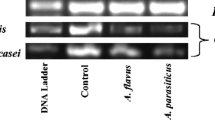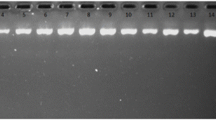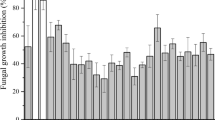Abstract
Certain strains of lactic acid bacteria have been reported to inhibit fungal growth and may so be potential as biocontrol agents. In this study, 171 LAB strains were isolated from traditional fermented Kenyan milk and maize products and tested against aflatoxin-producing A. flavus fungi. The three LAB strains showing highest antifungal activity were identified as Lactobacillus plantarum. None of the strains were able to completely inhibit fungal growth under conditions favorable for fungi and suboptimal for LAB. These conditions probably reduced the growth and metabolic activity of some LAB isolates, as several growth-related aspects like production of antifungal biomolecules and other metabolites contribute to the inhibiting activity. The results suggest that certain LAB strains could be employed in food to control the growth of aflatoxigenic fungi. Further studies to establish the efficacy of the potential LAB strains in fermented products are in progress.


Similar content being viewed by others
References
Ahlberg S, Joutsjoki V, Korhonen JH (2015) Potential of lactic acid bacteria in aflatoxin risk mitigation. Int J Food Microbiol 207:87–102. doi:10.1016/j.ijfoodmicro.2015.04.042
Belkacem-Hanfi N, Fhoula I, Semmar N, Guesmi A, Perraud-Gaime I, Ouzari HI, Boudabous A, Roussos S (2014) Lactic acid bacteria against post-harvest moulds and ochratoxin A isolated from stored wheat. Biol Control 76:52–59. doi:10.1016/j.biocontrol.2014.05.001
Chauhan Y, Tatnell J, Krosch S, Karanja J, Gnonlonfin B, Wanjuki I, Wainana J, Harvey J (2015) An improved simulation model to predict pre-harvest aflatoxin risk in maize. Field Crops Res 178:91–99. doi:10.1016/j.fcr.2015.03.024
Dalie DKD, Deschamps AM, Richard-Forget F (2010) Lactic acid bacteria—potential for control of mould growth and mycotoxins: a review. Food Control 21:370–380. doi:10.1016/j.foodcont.2009.07.011
Darwish WS, Ikenaka Y, Nakayama SMM, Ishizuka M (2014) An overview on mycotoxin contamination of foods in Africa. J Vet Med Sci 76:789–797
Edwards U, Rogall T, Blocker H, Emde M, Bottget EC (1989) Isolation and direct complete nucleotide determination of entire genes. Characterizations of a gene coding for 16S ribosomal RNA. Nucl Acids Res 17:7843–7853
Elmabrok AS, Hassan Z, Mokhtar AM, Aween MM (2012) Efficacy of Lactobacillus plantarum C5 cell and their supernatant against Colletotrichum gloeosporioides on germination rate of chilli seeds. Res J Biol Sci 7:159–164
Gerez CA, Dallagnol A, Ponsone L, Chulze S, Font de Valdez G (2014) Ochratoxin A production by Aspergillus niger: effect of water activity and a biopreserver formulated with Lactobacillus plantarum CRL 778. Food Control 45:115–119
Kachouri F, Ksontini H, Hamdi M (2014) Removal of Aflatoxin B1 and Inhibition of Aspergillus flavus Growth by the Use of Lactobacillus plantarum on Olives. J Food Prot 77:1760–1767
Kang’ethe EK, Langat KA (2009) Aflatoxin B1 and M1 contamination of animal feeds and milk from urban centers in Kenya. Afr Health Sci 9:218–226
Marin S, Ramos AJ, Cano-Sancho G, Sanchis V (2013) Review: mycotoxins: occurrence, toxicology, and exposure assessment. Food Chem Toxicol 60:218–237
Muhialdin BJ, Hassan Z, Abu Bakar F, Saari N (2016) Identification of antifungal peptides produced by Lactobacillus plantarum IS10 grown in the MRS broth. Food Control 59:27–30. doi:10.1016/j.foodcont.2015.05.022
Mukanga M, Derera J, Tongoona P, Laing MD (2010) A survey of pre-harvest ear rot diseases of maize and associated mycotoxins in south and central Zambia. Int J Food Microbiol 141:213–221
Muñoz R, Arena ME, Silva J, González SN (2010) Inhibition of mycotoxin-producing Aspergillus nomius VSC 23 by lactic acid bacteria and Saccharomyces cerevisiae. Braz J Microbiol 41:1019–1026
Okoth S, Nyongesa B, Ayugi V, Kang’ethe E, Korhonen H, Joutsjoki V (2012) Toxigenic potential of aspergillus species Occurring on maize kernels from two agro-ecological zones in Kenya. Toxins 4:991–1007. doi:10.3390/toxins4110991
Okoth S, Nyongesa B, Joutsjoki V, Korhonen H, Ayugi V, Kang’ethe EK (2016) Sclerotia formaton and toxin production in large sclerotial Aspergillus flavus isolates from Kenya. Adv Microbiol 6:47–56
Pierides M, El-Nezami H, Peltonen K, Salminen S, Ahokas J (2000) Ability of Dairy Strains of Lactic Acid Bacteria to Bind Aflatoxin M1 in a Food Model. J Food Prot 63:645–650
Sangmanee P, Hongpattarakere T (2014) Inhibitory of multiple antifungal components produced by Lactobacillus plantarum K35 on growth, aflatoxin production and ultrastructure alterations of Aspergillus flavus and Aspergillus parasiticus. Food Control 40:224–233. doi:10.1016/j.foodcont.2013.12.005
Shetty PH, Hald B, Jespersen L (2007) Surface binding of aflatoxin B1 by Saccharomyces cerevisiae strains with potential decontaminating abilities in indigenous fermented foods. Int J Food Microbiol 113(1):41–46. doi:10.1016/j.ijfoodmicro.2006.07.013
Sirma A, Ouko EO, Murithi G, Mburugu C, Mapenay I, Ombui JN, Kang’ethe EK, Korhonen H (2015) Prevalence of aflatoxin contamination in cereals from Nandi County, Kenya. Int J Agric Sci Vet Med 3:55–63
Torriani S, Felis GE, Dellaglio F (2001) Differentiation of Lactobacillus plantarum, L. pentosus, and L. paraplantarum by recA gene sequence analysis and multiplex PCR assay with recA gene-derived primers. Appl Environ Microbiol 67:2450–3454
Varhimo E, Varmanen P, Fallarero A, Skogman M, Pyörälä S, Iivanainen A, Sukura A, Vuorela P, Savijoki K (2011) Alpha- and b -casein components of host milk induce biofilm formation in the mastitis bacterium Streptococcus uberis. Vet Microbiol 149:381–389
Acknowledgements
This article was prepared as a contribution to the Food Africa Programme which is mainly financed by the Ministry for Foreign Affairs of Finland Contract No. 29891501 (Food Africa). The kind assistance of International Livestock Research Institute (ILRI) and the Institute of Biotechnology, University of Helsinki with the support of the laboratory analysis is acknowledged.
Author information
Authors and Affiliations
Corresponding author
Additional information
Communicated by Erko Stackebrandt.
Rights and permissions
About this article
Cite this article
Ahlberg, S., Joutsjoki, V., Laurikkala, S. et al. Aspergillus flavus growth inhibition by Lactobacillus strains isolated from traditional fermented Kenyan milk and maize products. Arch Microbiol 199, 457–464 (2017). https://doi.org/10.1007/s00203-016-1316-3
Received:
Revised:
Accepted:
Published:
Issue Date:
DOI: https://doi.org/10.1007/s00203-016-1316-3




